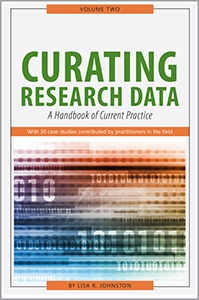Primary tabs
You don't need to be an ALA Member to purchase from the ALA Store, but you'll be asked to create an online account/profile during the checkout to proceed. This Web Account is for both Members and non-Members.
If you are Tax-Exempt, please verify that your account is currently set up as exempt before placing your order, as our new fulfillment center will need current documentation. Learn how to verify here.
- Description
- Table of Contents
- About the author
Data are becoming the proverbial coin of the digital realm: a research commodity that might purchase reputation credit in a disciplinary culture of data sharing, or buy transparency when faced with funding agency mandates or publisher scrutiny. Unlike most monetary systems, however, digital data can flow in all too great an abundance. Not only does this currency actually "grow" on trees, but it comes from animals, books, thoughts, and each of us! And that is what makes data curation so essential. The abundance of digital research data challenges library and information science professionals to harness this flow of information streaming from research discovery and scholarly pursuit and preserve the unique evidence for future use.
Curating Research Data, Volume Two: A Handbook of Current Practice guides you across the data lifecycle through the practical strategies and techniques for curating research data in a digital repository setting. The data curation steps for receiving, appraising, selecting, ingesting, transforming, describing, contextualizing, disseminating, and preserving digital research data are each explored, and then supplemented with detailed case studies written by more than forty international practitioners from national, disciplinary, and institutional data repositories. The steps in this volume detail the sequential actions that you might take to curate a data set from receiving the data (Step 1) to eventual reuse (Step 8). Data curators, archivists, research data management specialists, subject librarians, institutional repository managers, and digital library staff will benefit from these current and practical approaches to data curation.
Digital data is ubiquitous and rapidly reshaping how scholarship progresses now and into the future. The information expertise of librarians can help ensure the resiliency of digital data, and the information it represents, by addressing how the meaning, integrity, and provenance of digital data generated by researchers today will be captured and conveyed to future researchers.
Acknowledgments
Foreword
Preliminary Step 0: Establish Your Data Curation Service
Step 1.0: Receive the Data
1.1 Recruit Data for Your Curation Service
1.2 Negotiate Deposit
1.3 Transfer Rights (Deposit Agreements)
1.4 Facilitate Data Transfer
1.5 Obtain Available Metadata and Documentation
1.6 Receive Notification of Data Arrival
Step 2.0: Appraisal and Selection Techniques that Mitigate Risks Inherent to Data
2.1 Appraisal
2.2 Risk Factors for Data Repositories
2.3 Inventory
2.4 Selection
2.5 Assign
Step 3.0: Processing and Treatment Actions for Data
3.1 Secure the Files
3.2 Create a Log of Actions Taken
3.3 Inspect the File Names and Structure
3.4 Open the Data Files
3.5 Attempt to Understand and Use the Data
3.6 Work with Author to Enhance the Submission
3.7 Consider the File Formats
3.8 File Arrangement and Description
Step 4.0: Ingest and Store Data in Your Repository
4.1 Ingest the Files
4.2 Store the Assets Securely
4.3 Develop Trust in Your Digital Repository
Step 5.0: Descriptive Metadata
5.1 Create and Apply Appropriate Metadata
5.2 Consider Disciplinary Metadata Standards for Data
Step 6.0: Access
6.1 Determine Appropriate Levels of Access
6.2 Apply the Terms of Use and Any Relevant Licenses
6.3 Contextualize the Data
6.4 Increase Exposure and Discovery
6.5 Apply Any Necessary Access Controls
6.6 Ensure Persistent Access and Encourage Appropriate Citation
6.7 Release Data for Access and Notify Author
Step 7.0: Preservation of Data for the Long Term
7.1 Preservation Planning for Long-Term Reuse
7.2 Monitor Preservation Needs and Take Action
Step 8.0: Reuse
8.1 Monitor Data Reuse
8.2 Collect Feedback about Data Reuse and Quality Issues
8.3 Provide Ongoing Support as Long as Necessary
8.4 Cease Data Curation
Brief Concluding Remarks and a Call to Action
Bibliography
Biographies
Lisa R. Johnston
Lisa R. Johnston is an Associate Librarian at the University of Minnesota, Twin Cities. Johnston serves as the libraries’ Research Data Management/Curation Lead and as Co-Director of the University Digital Conservancy, the University of Minnesota’s institutional repository. In 2014, Johnston led the team that developed and launched the Data Repository for the University of Minnesota (DRUM), http://hdl.handle.net/11299/166578. She serves as principal investigator of the multi-institution collaboration, the Data Curation Network project, which launched in 2016 with funding from the Alfred P. Sloan Foundation. Johnston has presented internationally on topics of academic library services for research data management, authored research articles on data management topics, and co-edited the book Data Information Literacy: Librarians, Data, and the Education of a New Generation of Researchers (Purdue University Press, eds. Carlson and Johnston, 2015), which details a variety of educational approaches used in data management training for STEM graduate students. Prior to becoming a librarian, Johnston was a science writer and assistant editor for Sky & Telescope magazine. Johnston holds a master of library science and bachelor of science in astrophysics, both from Indiana University, and was certified by the Society of American Archivists as a Digital Curation Specialist. Her ORCID is http://orcid.org/0000-0001-6908-9240.



